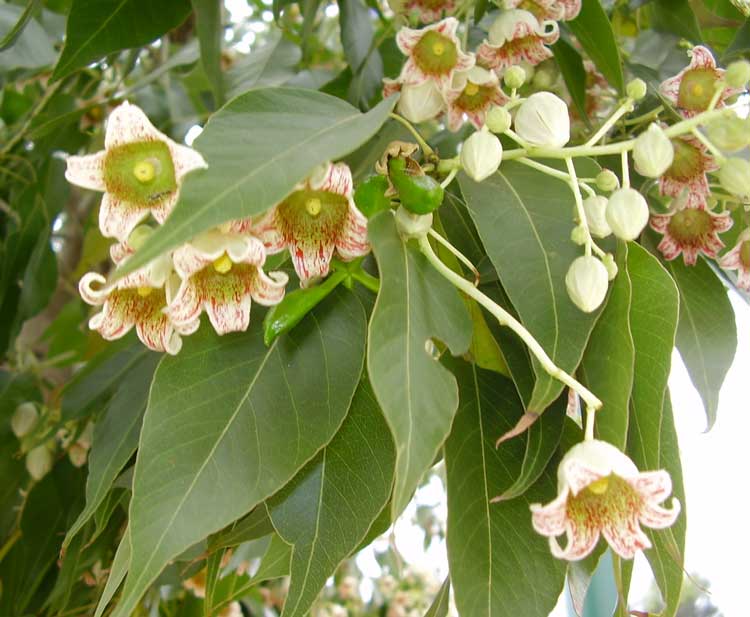
Brachychiton populneus (*)
Classification System: APG IV
Superregnum: Eukaryota
Regnum: Plantae
Cladus: Angiosperms
Cladus: Eudicots
Cladus: Core eudicots
Cladus: Rosids
Cladus: Eurosids II
Ordo: Malvales
Familia: Malvaceae
Subfamilia: Sterculioideae
Genus: Brachychiton
Sectio: B. sect. Poecilodermis
Species: Brachychiton populneus
Name
Brachychiton populneus (Schott & Endl.) R.Br.
References
J. J. Bennett & R. Brown, Pl. jav. rar. 234. 1844
USDA, ARS, Germplasm Resources Information Network. Brachychiton populneus in the Germplasm Resources Information Network (GRIN), U.S. Department of Agriculture Agricultural Research Service. Accessed: 07-Oct-06.
Brachychiton populneus, commonly known as the kurrajong,[1] is a small to medium-sized tree found naturally in Australia in a diversity of habitats from wetter coastal districts to semi-arid interiors of Victoria, New South Wales and Queensland. Carrejun and carrejan were the indigenous names of trees in the foothills of the Blue Mountains near Sydney, and the bark was used for twine and fishing lines.[2] The extended trunk is a water storage device for survival in a warm dry climate. The bell-shaped flowers are variable in colour (pale to pink) while the leaves vary considerably in shape. The leaves are either simple and pointed, or may be 3–9 lobed. Saplings grow from a drought and fire resistant tap-rooted tuber.
The kurrajong has multiple uses and was used by many Australian Aboriginal clans and tribes around Australia. The seeds located in a seed pod were often removed and cleaned of the fine hairs within the seed pod and were often roasted.[3] Water could be obtained from the tree roots by boring a hole in the trunk and squeezing the wood.[4] There are also records of the seedpods being turned into a children's rattle or toy. The soft spongy wood was used for making shields, and the bark as a fibre. The leaves are also used as emergency fodder for drought-affected animal stock. There has also been records of European settlers using the seeds as a coffee supplement by roasting and crushing the seeds.[3]
It has been introduced as an ornamental tree to south-western Australia, South Africa, Louisiana, California, Arizona and Mediterranean countries. In Western Australia it was observed to be invasive in disturbed areas.
Horticulturists have hybridised the kurrajong with related Brachychiton species, including the Queensland bottle tree (B. rupestris) and Illawarra flame tree (B. acerifolius) to produce new garden ornamentals.{{cn|date=March 2022}}
The specific name Brachychiton populneus pertains to a perceived similarity to genus Populus, the poplars. Sometimes B. populneus is also known by the names "lacebark kurrajong" and "bottle tree" (USA). However, B. discolor is also referred to as the lacebark kurrajong, and Bottle Tree is a term commonly applied not only to other species of Brachychiton but to members of other genera around the world.
The kurrajong has been recorded as a host plant for the mistletoe species Dendrophthoe glabrescens.[5]
References
Floyd, A.G., Rainforest Trees of Mainland South-eastern Australia, 1989, p391
Sarskens G. People of the River , 2020, p180
Low, Tim (1988). Wild Food Plants of Australia. Angus & Robertson. p. 183. ISBN 0-207-14383-8.
Ngarigo Plant Use in the snow River Catchment
Downey, Paul O. (1998). "An inventory of host species for each aerial mistletoe species (Loranthaceae and Viscaceae) in Australia" (PDF). Cunninghamia. 5 (3): 685–720. Archived from the original (PDF) on 2013-04-25.
Macoboy, S. (1991) What tree is that?, ISBN 1-86302-131-0
Retrieved from "http://en.wikipedia.org/"
All text is available under the terms of the GNU Free Documentation License

